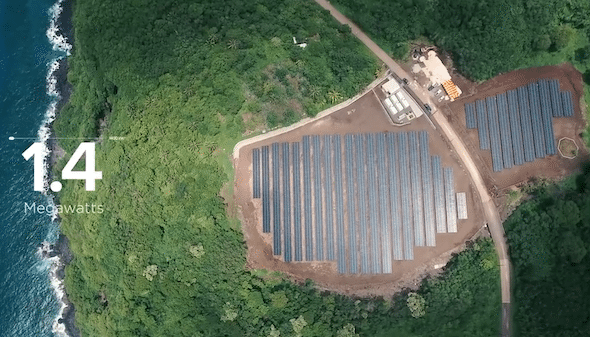
On top of releasing a new line on residential and commercial battery storage, unveiling a range of integrated solar roofing tiles, and pulling off a a $2.6 billion merger, Tesla and Solar City have also been busy tapping into the potentially huge global renewable energy microgrid market.
The newly united companies announced the completion of a solar plus battery storage project on the island of Ta’u in American Samoa in a tweet – of course – last Tuesday, along with a video (see below).
The Ta’u microgrid combines 1.4MW of solar PV and a 6MWh energy storage system made up of 60 of Tesla’s lithium-ion Powerpacks; which Tesla claims can keep the island powered for three full days without sun, with the battery storage able to fully recharge in just 7 hours of sunlight.

Of course, Ta’u – which has traditionally imported diesel fuel for its electricity supply – is not the only island or remote community to make the switch to a renewable energy plus storage based microgrid. And Telsa and Solar City are certainly not the first companies to facilitate such a change. There is a lot of this work already going on – and plenty more to come.
As we reported here last month, Australia’s own Carnegie Wave Energy recently trebled its bet on what it sees as a booming micro-grid market in Australia and overseas, by moving to take full ownership of the solar, battery storage and micro-grid business Energy Made Clean.
Last year, the Perth-based company’s plans to use its world-leading CETO wave energy technology to develop a renewable energy microgrid for Mauritius won $800,000 in funding from the Australian government.
But Tesla’s America Samoa project is decent first bite at the microgrid market, and demonstrates the extent of the US company’s ambition, which extends well beyond electric vehicles and home energy solutions.

As Tesla notes in its video, more than 100,000 gallons of diesel fuel a year has been used to provide electricity to the island’s almost 600 residents, which, when you have to ship the diesel in, is a costly exercise as well as an unreliable one.
So as well as being clean, the microgrid — which was co-funded by the American Samoa Economic Development Authority, the US Environmental Protection Agency, and the Department of Interior — will save the island on energy costs.

Sophie is editor of One Step Off The Grid and deputy editor of its sister site, Renew Economy. Sophie has been writing about clean energy for more than a decade.
